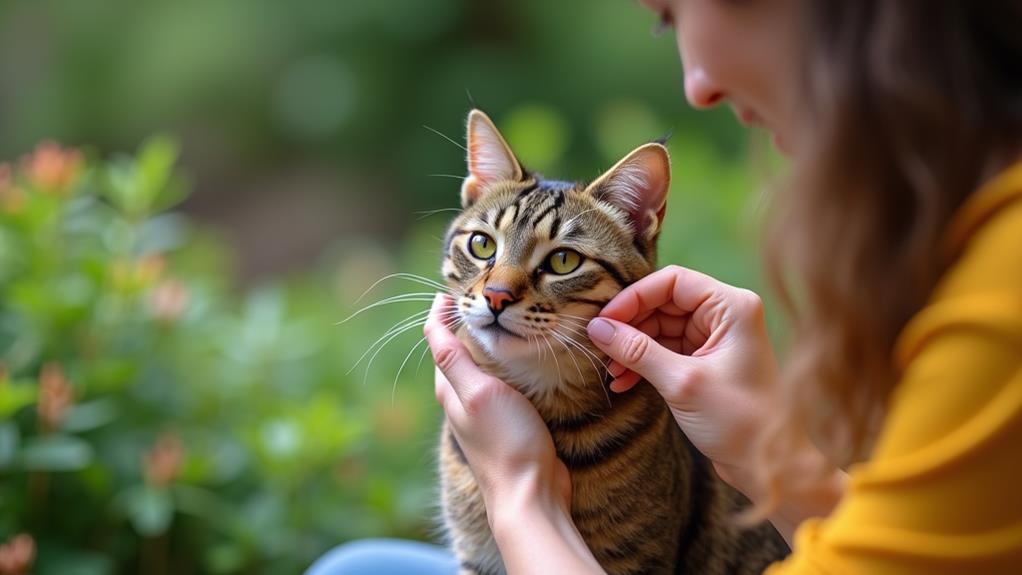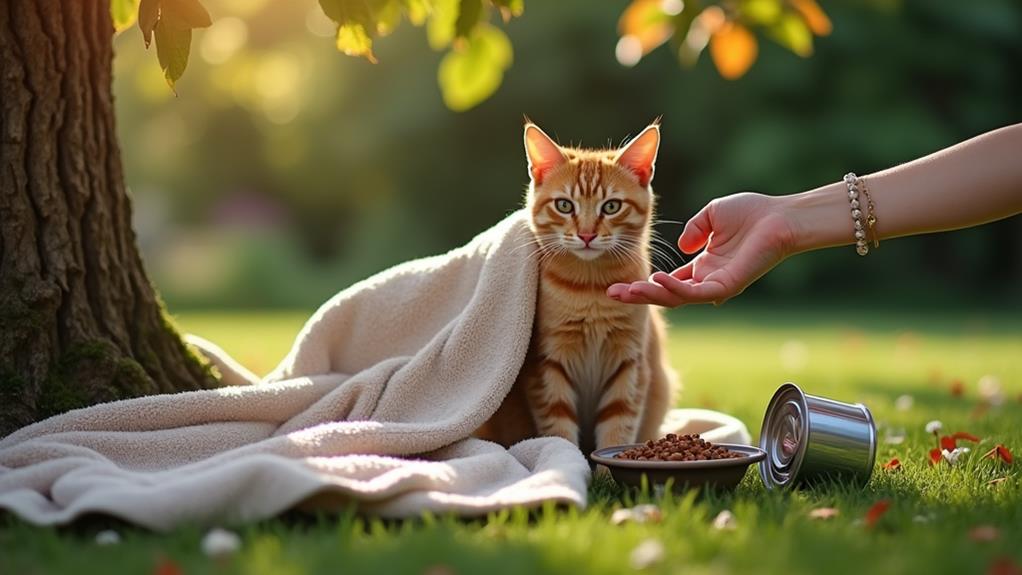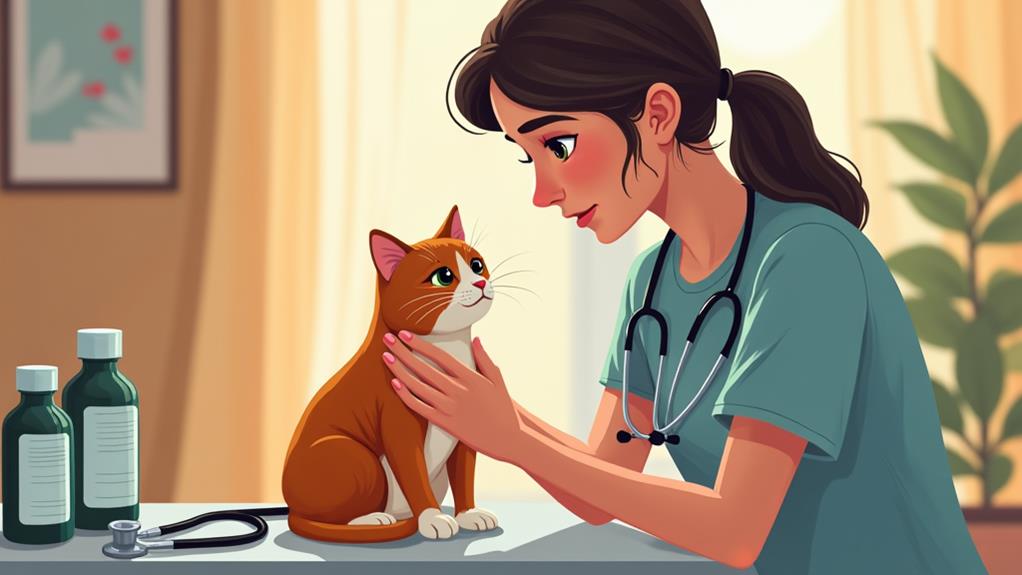How to Treat a Feral Cat With an Upper Respiratory Infection

To treat a feral cat with an upper respiratory infection, start by safely capturing it using a humane trap. Set up a warm, quiet space where the cat can rest. Clean its eyes and nose gently with a warm, moist cloth to promote comfort. Offer aromatic, wet food and fresh water to encourage eating and maintain hydration. If you notice worsening symptoms or the cat struggles to breathe, seek veterinary help immediately. Administer prescribed medications carefully and monitor for improvements. Consistently isolating the cat helps prevent infection spread. Uncover more steps to guarantee the cat's recovery and health.
Capturing and Handling Safely
Start by using a humane trap to capture feral cats, confirming it's properly baited with enticing food like tuna or canned cat food. This increases your chances of capturing them successfully. Once trapped, approach the cat calmly and quietly to minimize stress. Sudden movements could frighten the animal, complicating the process and possibly worsening any upper respiratory infection they might have.
When handling safely, always wear thick gloves to protect yourself and the cat. Use a blanket or towel to cover the trap during transportation. This not only soothes the cat but also prevents escape or injury. It's vital to keep the captured cat in a quiet, secure location away from other animals. This environment reduces anxiety and minimizes the risk of spreading any potential infection.
After capturing, promptly consult a veterinarian. They'll provide appropriate treatment for the cat's upper respiratory infection and address other health concerns. Quick veterinary attention is fundamental for effective treatment. By following these steps, you guarantee the feral cat is handled safely and with minimal stress, setting the stage for recovery and improved health.
Recognizing Symptoms
Recognizing the symptoms of upper respiratory infections (URI) in feral cats is crucial for timely and effective treatment. Cats suffering from URI often show signs like sneezing, nasal congestion, and discharge from the nose or eyes. This discharge can vary, appearing either clear or purulent. If you notice these symptoms, it is vital to act quickly, as timely care can prevent the infection from spreading to other cats.
Besides the more obvious symptoms, watch for signs of lethargy and decreased appetite. These can indicate a more severe infection, especially if the cat also has a fever. Infections caused by Feline herpesvirus (FHV) and Feline calicivirus (FCV) might also result in oral ulcers, making eating painful and further reducing the cat's desire to eat.
Be aware that URI symptoms can last from one to three weeks, but if the condition worsens, complications such as pneumonia may arise. Difficulty breathing is a serious symptom that requires immediate attention. By recognizing these signs early, you can intervene before the situation escalates, ensuring the feral cat receives the necessary care and support for recovery.
Providing Initial Care

When you spot a feral cat showing signs of an upper respiratory infection, providing initial care promptly can make a notable difference in its recovery. Start by setting up a quiet and warm resting area. A calm environment contributes to the cat's comfort and aids in healing. Gently clean the cat's nose and eyes with a warm, moist cloth to remove discharge, which will help improve its comfort and breathing.
Next, entice the cat to eat by offering aromatic, wet food. Proper nutrition is vital for recovery during an upper respiratory infection. If the cat struggles with nasal congestion, use a humidifier or create steam from a hot shower to ease its breathing. This added moisture can help clear nasal passages, making it easier for the cat to breathe.
It's important to monitor the cat closely for any worsening symptoms. Keep an eye out for difficulty breathing or any lack of improvement, as these may necessitate veterinary intervention. By providing this initial care, you're giving the feral cat the best chance for a comfortable and speedy recovery. Your attention and efforts can greatly impact its path to wellness.
Nutrition and Hydration Tips
Nourishment plays an important role in aiding a feral cat's recovery from an upper respiratory infection. When a cat's appetite decreases, offering a variety of soft, aromatic, and moist foods can make a significant difference. These types of foods can entice them to eat, providing vital nutrition despite their symptoms. Make sure the cat always has access to fresh water, as proper hydration helps thin mucus and eases respiratory distress.
If the cat hesitates to drink, consider offering tuna juice or low-sodium chicken broth. These alternatives can enhance fluid intake while providing supplementary nutrients important for recovery. Nasal congestion can further complicate eating and drinking. To address this, consider using a humidifier or letting steam from a hot shower circulate in the room. This can help relieve congestion, encouraging a better appetite.
Keep a close eye on the cat's weight and general condition. Prolonged lack of nutrition can lead to serious health issues. If the cat's condition doesn't improve, veterinary intervention may be necessary. By managing their nutrition and hydration effectively, you can support their recovery and improve their chances of overcoming the infection.
When to Seek Veterinary Help

If you notice a feral cat isn't eating for more than 24 hours, it's vital to seek veterinary help. This behavior could signal a worsening upper respiratory infection or another severe health issue. Be vigilant for green or yellow nasal discharge or eye discharge, as these signs often indicate the need for antibiotics. Contact a vet promptly to prevent the infection from escalating.
Difficulty breathing, such as panting or wheezing, demands immediate attention. These symptoms could point to a serious complication that requires expert intervention. Don't wait too long to act; swift action can make a big difference in the cat's recovery.
Persistent vomiting or diarrhea over 24 hours in a feral cat warrants a trip to the vet. These issues can quickly lead to dehydration, further endangering the cat's health. A veterinary examination within 3-7 days of noticing symptoms is vital. Early diagnosis and treatment can help manage the upper respiratory infection effectively.
Administering Medications
Administering medication to a feral cat can be an exercise in patience and empathy. When dealing with a feral cat suffering from an upper respiratory infection, it's vital to create a safe environment for both you and the cat. Using a tranquilizer or sedative is often necessary to reduce stress, which can worsen the cat's condition. Once you've safely secured the cat, you can start administering medications.
For secondary bacterial infections, doxycycline is commonly prescribed. Make certain to follow the veterinarian's instructions for dosage to guarantee effectiveness. If the feral cat can't take oral medications, injectable antibiotics might be a more suitable alternative. This method allows you to administer the treatment with less stress and guarantees the cat receives the full benefit of the medication.
Always use medications specifically formulated for cats, as human medications can be harmful. Monitor the cat's response closely after administering medications, watching for signs of improvement or any adverse reactions. If the cat doesn't show improvement within a few days, or if any concerning symptoms arise, consult your veterinarian promptly. This careful approach helps safeguard the well-being of the feral cat during its recovery.
Preventing Future Infections

After guaranteeing a feral cat receives the right medications, it's critical to focus on preventing future infections. Start by scheduling regular vaccinations against Feline Herpesvirus (FHV) and Feline Calicivirus (FCV). These vaccinations are crucial in lowering the risk of upper respiratory infections within feral cat populations. Maintaining good hygiene practices plays an similarly significant role. Clean feeding and litter areas consistently to minimize the spread of infectious agents among the cats.
Quarantining new or sick feral cats before they join a colony is another effective strategy. By isolating these cats, you prevent potential outbreaks of respiratory infections in the established group. Creating a stress-free environment also contributes considerably to their well-being. Reducing stress, alongside providing adequate nutrition, strengthens their immune systems, making them less susceptible to infections.
Consistent monitoring of feral cat colonies is imperative. Keep an eye on their health and promptly address any signs of respiratory infections. Early intervention can considerably reduce the incidence of these illnesses. By implementing these practices, you help guarantee the feral cats in your care remain healthy and resilient against future infections.
Managing Long-term Health
To manage the long-term health of feral cats effectively, prioritize regular veterinary check-ups. These visits are imperative, especially after a cat has recovered from an upper respiratory infection (URI). They help guarantee that no lingering complications arise and that chronic issues don't develop. Vaccination against URI-causing viruses like Feline Herpesvirus and Feline Calicivirus is also fundamental. It reduces the risk of future infections and leads to better long-term health outcomes.
Creating a stress-free environment and providing proper nutrition are critical for supporting a cat's immune system. A strong immune system is essential for comprehensive health and resilience against infections. Observing each cat regularly for any signs of returning symptoms, such as sneezing or nasal discharge, allows you to catch potential issues early. Early intervention can prevent a minor problem from escalating into a more serious health concern.
Keep detailed records of any health issues and treatments received. This documentation helps track recovery progress and informs future care decisions. When managing multiple cats, this information is priceless for guaranteeing that each cat receives the care they need to maintain their long-term health.




